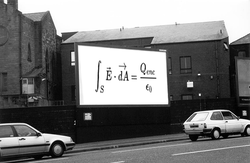Can the Prince save you now?
 Gauss' law is a very powerful method to determine the electric field due to a distribution of charges. It can, for instance, be used to find the electric field due to an infinite plate. However, it is usually useless whenever there is a non-uniform field, i.e. there is broken symmetry.
Gauss' law is a very powerful method to determine the electric field due to a distribution of charges. It can, for instance, be used to find the electric field due to an infinite plate. However, it is usually useless whenever there is a non-uniform field, i.e. there is broken symmetry.
One such case is that of a finite rectangular plate. Find the electric field due to a uniformly charged rectangular plate at a point 1 m above its center of mass.
Details And Assumptions
- Length = 8 1 3 m
- Breadth = 3 m
- Total Charge on plate = 8 × 1 0 − 8 C
- k = 9 × 1 0 9 C 2 Nm 2
- Plate is an Insulator
This is an original problem.
The answer is 349.167.
This section requires Javascript.
You are seeing this because something didn't load right. We suggest you, (a) try
refreshing the page, (b) enabling javascript if it is disabled on your browser and,
finally, (c)
loading the
non-javascript version of this page
. We're sorry about the hassle.
2 solutions
Same way ! BTW I wanted to know whether Gauss can be of any help.
Log in to reply
The prince can't save us.
Even i did in the same way but b4 the question was only an integer. So i messed up :'(
The problem is very similar to A charge oscillating above a charged square plate
Let p = 2 a and q = 2 b
Consider two line charges parallel to each other and at same distance from center. We already know the formula for electric field of line charge. We take only vertical component.The small electric field due to these line charges is: d E = π ϵ 0 ( h 2 + x 2 ) h 2 + q 2 + x 2 σ h p
Hence, the net electric field is: E = π ϵ 0 σ h p ∫ 0 q ( h 2 + x 2 ) h 2 + q 2 + x 2 d x
Substituting x 2 ( h 2 + p 2 ) + 1 = t 2 ,
E = π ϵ 0 h σ p ∫ q 2 h 2 + p 2 + 1 ∞ t 2 h 2 + p 2 d t
= π ϵ 0 σ arctan ( p h t ) ∣ ∣ ∣ ∣ ∣ q 2 h 2 + p 2 + 1 ∞
= π ϵ 0 σ arctan ( h h 2 + p 2 + q 2 p q )
where σ = a b q , p = 2 a , and q = 2 b
Notice that if p and q are very huge, the field approaches 2 ϵ 0 σ , which is the one of an infinite plane.
Nice ! But the root stays same :)
Log in to reply
Nice question bro
Did the same way !
My solution involves the use of double integrals that are pretty easy to solve(believe me).
Assume the plate to be part of the xy- plane with the boundaries defined by the equations : x = a / 2 , x = − a / 2 , y = b / 2 , y = − b / 2
We want to find the electric field due to the whole plate at the point ( 0 , 0 , d )
It is pretty obvious that the resultant electric field would be in +ve z direction.
Hence we would be integrating for z-component of electric field.
Take a infinitesimal area element at a point ( x , y ) having area d x d y . Electric field due to that element is given by :
d 2 E = x 2 + y 2 + d 2 k σ d x d y cos θ
Where θ is angle made by the net electric field by that element with the z-axis.
Now c o s ( θ ) = x 2 + y 2 + d 2 d
Putting the expression the double integral comes out to be :
E = ∫ − b / 2 b / 2 ∫ − a / 2 a / 2 ( x 2 + y 2 + d 2 ) 3 / 2 k d σ d x d y
Solving the double integral and putting the value of σ ,the closed form comes out to be :
E = a b 4 k q tan − 1 ( 2 d a 2 + b 2 + 4 d 2 a b )
Where q = Total charge, a , b = Length and breadth of the plate respectively, d = distance of the point from the centre of mass.